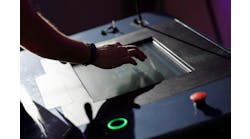Part of a growing trend is built-in human-machine interface (HMI) with the programmable-logic-controller (PLC) chassis for local machine and process control. The HMI is a necessity for on-site operation, troubleshooting and control of the end result, which is productivity, efficiency and availability.
It stands to reason that the HMI graphics and control elements be accessible to the operator in some form or another.
Another trend is that the HMI is on a network with remote viewing capabilities. In this form or manner the user dials into the HMI using a separate device such as a smart phone to view the process graphics in order to make changes, for example.
In past years, my experience has been that you should not make changes to a machine or process without actually being there. What could go wrong with that?
Troubleshooting has the same general requirement, although not as stringent. Making code changes and/or troubleshooting a PLC program is much easier than trying to tweak a machine-cylinder stroke blindly.
I have successfully changed PLC code remotely to fix an issue; however, I always had a set of eyes on the system to view the results.
Having said that, if the issue is not with the PLC, but in the configuration of the process, then local and accessible HMI is required. In that mindset, an HMI needs to be mounted in an environmentally appropriate enclosure. Nine times out of 10, that enclosure is the main control cabinet where main power and motor control is.
I have also seen HMI screens mounted in motor control centers (MCCs) where the motor control is smart and the access to information from those MCC pans is done through an internal network.
One advantage of a cabinet-mounted HMI is the lack of external wiring—probably a network cable—which potentially brings in a point of failure. Reducing these points of failure is paramount in any automation control system design.
For HMIs in hazardous locations with gas and dust, it makes a lot of sense to include the HMI in the main control cabinet. The HMI becomes an integral part of the design.
On the factory floor, absent of any issues, a standard NEMA 12 cabinet would serve a perfect resting place for the screen.
Visibility to the process has to be a consideration. Typically the main control panel would be located close to the process to reduce installation costs and wiring time. Cabinet orientation is important so that the operator can have visual access to the process while accessing the information on the HMI screen.
On a film wrapper I worked on, I was surprised to see the HMI mounted on the side panel of the control cabinet. I assumed that was done due to panel depth. The problem was that, when you were standing in front of the HMI, you had to peer around the cabinet to see the process. Saving time and money should only go so far.
While a separate cabinet would be useful in that case, one would have to worry about crating for shipping, for example.
In past years, HMI form factors were not as they are now. They had huge Faraday cages around them to protect from commutating devices, as well as transformer-based power supplies. Cathode-ray tube (CRT) terminals were the display of choice; actually, there was no choice.
Now, they are flat screens with switching power supplies and light-emitting-diode (LED) brightness, leaving no excuses for proper installation and orientation.
Part of the advantage of installing the HMI in the main control panel is the ongoing issue of security. Typically, the control panels are locked, or at least should be, so that only qualified people can enter. This allows for controlled access to the contents of the panel including the HMI.
Some HMIs may be a separate device using a screen for display. While this is more common in supervisory-control-and-data-acquisition (SCADA) systems, there is nothing to say that this can’t be a situation for HMI.
Some SCADA software doubles as HMI, as well. When this is the case, there is remote and mobile support for most, which means that the HMI screens can be accessed anywhere; this may suggest that there may not even be a screen at all.
Some may select that approach due to cost savings or the true mobility of the operations staff.
Many moving parts in any operation must be considered when reviewing the design and implementation of operational screen devices. Good practices will be a benefit for years to come, regardless of the change in personnel.
Touch, mouse or keyboard doesn’t change the equation. Be nice to the operators, and they will save your 3-AM bacon.





